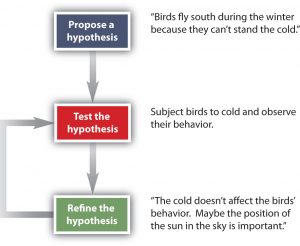The Scientific Method
Chemistry is a science based on observation and experimentation. We make observations and conduct experiments according to the scientific method. The scientific method is an organized procedure for investigating answers to questions. To find the answer to a question using the scientific method (for example, “Why do birds fly toward Earth’s equator during the cold months?”), complete the following steps:
- Make an observation. The observation could be in the form of a question, like “Why do birds fly toward Earth’s equator during the cold months?”
- Propose a hypothesis. A hypothesis is a tentative explanation of an observation. The hypothesis may be phrased as an answer to the question proposed in step 1, like “Birds fly south during the winter because they can’t stand the cold.” A hypothesis must be testable, so we can gather data that will either support or disprove the hypothesis.
- Test the hypothesis. The hypothesis is evaluated by devising and carrying out experiments to test it. If the hypothesis does not pass the test, then it is invalid. If an hypothesis can be replicated many times with the same result, we can be more certain that it is valid.
- Repeat the experiment, refining the hypothesis if necessary. If the hypothesis does not pass the test, it will need to be modified and tested again. Sometimes the results show the original hypothesis to be completely wrong, in which case a brand new hypothesis is proposed. Even if the hypothesis passes the test, it is important to repeat the test to be certain of the result.

Not all scientific investigations are simple enough to be separated into these discrete steps. But these steps represent the general method by which scientists learn about our natural universe. You can use the scientific method to answer your own questions and better understand the world around you!
If a hypothesis if found to accurately explain a large body of experimental data after repeated testing, then it can reach the status of a theory. Outside of scientific discussion, the word theory may be used in place of hypothesis, but it is important to recognize that a scientific theory is much, much stronger than a hypothesis. Scientific theories are well-substantiated, comprehensive, testable explanations of particular aspects of nature. They are backed up by large sets of data and repeated, rigorous testing. One example is the theory of gravity – we know from generations upon generations of experience that when we drop a ball, it will fall towards Earth, not upward into space. Scientific theories represent the highest level of scientific understanding, yet are not permanent; they can be modified if new data become available.
Attributions
This page is based on “Chemistry 2e” by Paul Flowers, Klaus Theopold, Richard Langley, William R. Robinson, PhD, Openstax which is licensed under CC BY 4.0. Access for free at https://openstax.org/books/chemistry-2e/pages/1-introduction
This page is based on “The Basics of General, Organic, and Biological Chemistry” by David W Ball, John W Hill, Rhonda J Scott, Saylor which is licensed under CC BY-NC-SA 4.0. Access for free at http://saylordotorg.github.io/text_the-basics-of-general-organic-and-biological-chemistry/index.html

